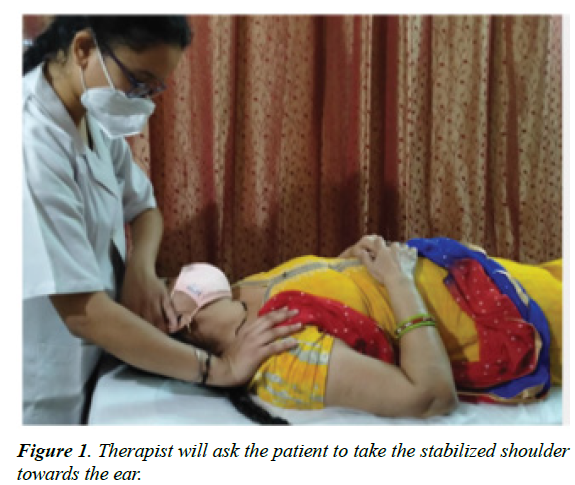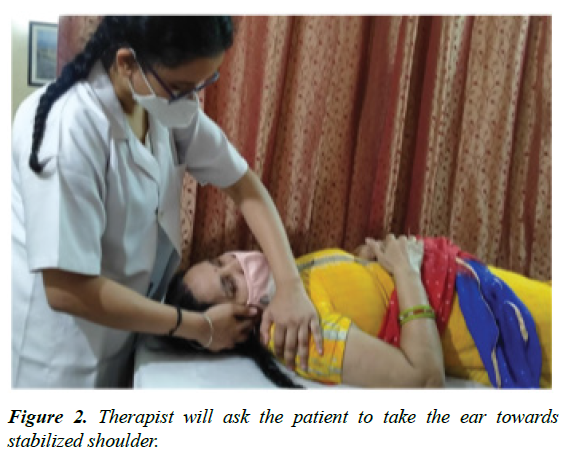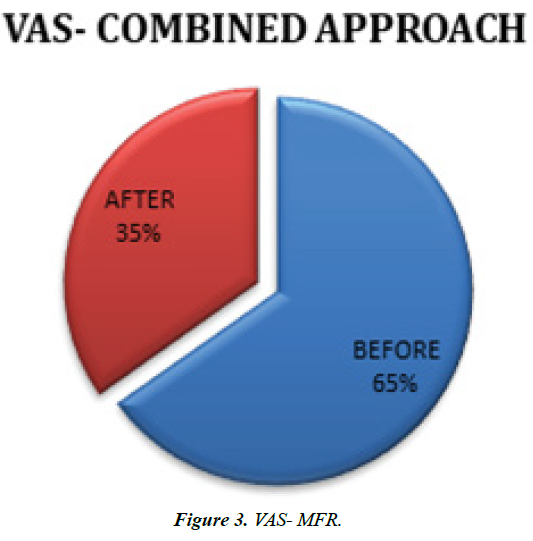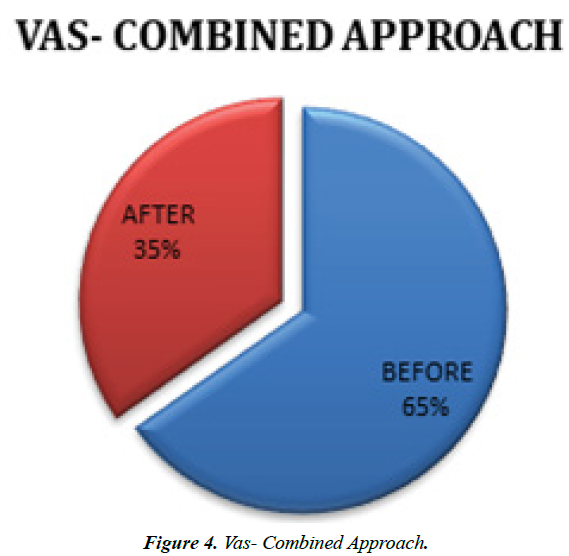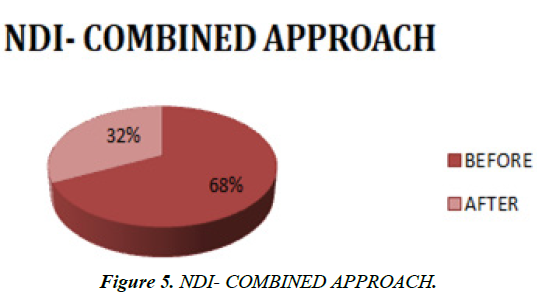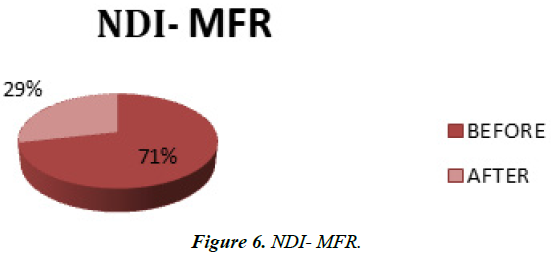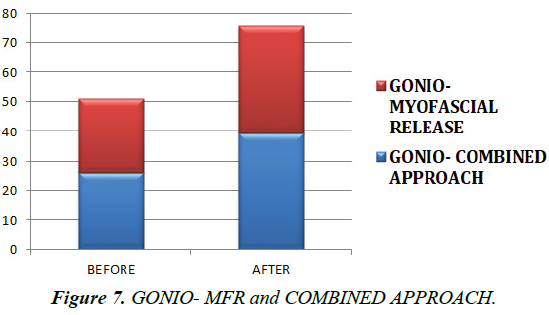Research Article - (2021) Volume 5, Issue 5
An immediate effect of myofascial release therapy and combined approach on myofascial trigger points in upper fibres of trapezius: A comparative study
Meena Gupta1, Meghna Negi2*, Sudha Yesentarao31Amity Institute of Physiotherapy, Amity University, Noida, Uttar Pradesh, India
2Amity Institute of Physiotherapy, Amity University, Noida, Uttar Pradesh, India
3Eminent Physiotherapy and Rehabilitation Center, Kendriya Vihar-2, Sector- 82, Noida, Uttar Pradesh, India
- *Corresponding Author:
- Meghna Negi
Amity Institute of physiotherapy
Amity University
Noida, Uttar Pradesh, India
Tel: 00989121909095
E-mail: meghnanegi1234@gmail.com
Accepted Date: September 09, 2021.
Citation: Negi M, Gupta M, Yesentarao S. An immediate effect of myofascial release therapy and combined approach on myofascial trigger points in upper fibres of trapezius: A comparative study.2021:5 (5):1-6
Abstract
Background: Neck pain is considered as an idiopathic condition but there are also various causes that may lead to a neck pain due to the muscle tightness, spasms, presence of trigger points and etc.
Due to this Covid-19 pandemic the IT professionals have to do their office work at a desk or the computer and spend their many hours with the same head posture which is a very common source of tension and neck pain. Bad postures also include the awkward head position while watching the television or using a thick pillow it may also lead to a neck pain.
Muscle energy technique, it is a kind of manual technique which involves soft tissue mobilization. This technique required patients own energy or efforts in the form of gentle isometric contraction to relax the tight muscle and promote the lengthening.
Myofascial release is a manual therapy; it is a type of rehabilitation tool. It is a hands-on therapy which means therapist use his/her manual power and apply sufficient amount of power into and onto the patient body.
Objective: To compare the efficacy Myofascial release therapy alone and combination of muscle energy technique and passive stretching and to find its immediate effect on myofascial trigger points in upper fibres of trapezius in terms of visual analogue scale, neck disability index NDI, and goniometery.
Methods: 20 subjects participated in this study of both sexes in age groups of 20-50 years were divided into two groups, group A and group B by simple random sampling method. Group-A: Combined Approach [Muscle Energy Technique + Passive Stretching] and Group B: Myofascial Release therapy.
VAS, NDI, cervical lateral flexion – goniometry were taken as Outcome measures. Subjects were assessed prior to the treatment, immediately after the treatment post readings were taken to see the carry over effect of treatment.
Results: MFR is more effective to improve pain, then compared to combined approach and combined approach is more effective in increasing range of motion.
Keywords
Muscle energy technique, Myofascial release therapy, Trigger points, Upper trapezius muscle.
Abbreviations
MFR- Myofascial Release Therapy; NDI- Neck Disability Index; VAS- Visual Analogue Scale, RA- Rheumatoid Arthritis; MET- Muscle Energy Technique; SD- standard deviation; Gonio – Goniometer.
Introduction
The problem in neck is a worldwide issue in a population. Neck pain is defined as a pain around the neck region which may or may not painful in one or both upper limbs [1-5]. Working on a same head posture which is not ergonomically correct, it may lead to musculoskeletal disorder that can often result in a disability [6]. The prevalence of neck pain is about 50 to 60% in every 6 months. In a general population 20% - 70% of adults are affected by neck pain in which it is seen that females are mostly affected by this neck paint as compared to the males. [4]
Trapezius is a trapezoidal shaped, broad and large superficial muscle which gets originate from the occipital bone to the lower vertebrae of thoracic and get inserted into the spine of the scapula. There are various function that are performed by this large muscle lateral flexion, extension, upward rotation of the scapula, scapular elevation and contralateral rotation of the neck [7]. The upper fibres of the trapezius muscle play a major role for the head posture and it is get affected due to the overuse activity, the muscle get shortened due to the restricted activity, or limited range of motion and it may cause to a spasms or tightness[5].
What is muscle spasm? Muscles spasm may occur early after injury is like the tightness of a specific muscle which may or may not be painful it is may be due to the shortness of the muscle there will be an involvement of trigger points. Muscle spasm cause formation of the muscle knots which we also called as trigger points [2,6].
The pathology behind the formation of trigger points is because of disturb posture or poor ergonomics of neck which may lead to the shortening of the muscle fibres now the disturb muscle receives less oxygen as well as low blood supply which will results to Less removal of metabolic waste and it will provide low level of nutrients two muscle fibres [8-10].
Objective of the study
To compare the efficacy MFR alone and combination of MET and passive stretching and to find its immediate effect on Myofascial trigger points in terms of visual analogue scale, neck disability index - NDI, and Goniometery and to know which is more beneficial between two techniques, on their immediate effects on Myofascial trigger points.
Materials and Methods
Study Design: Comparative Study
Study Population: Orthopedic Out Patient Department.
Sample population: 20 patients both sexes in age groups of 20- 50 years were divided into two groups, group A and group B by simple Random sampling method.
Place of data collection: Eminent Physiotherapy and Rehabilitation Center.
Sample size- 20
Instruments required:
• Neck Disability Index
• Goniometry
• VAS
Selection criteria:
Inclusion criteria-
• Patients with non-articular neck pain
• Age group 20-50 years of either sex
• Cases of upper trapezius spasm
• Pain felt maximally over upper trapezius region
• Active trigger points in the Trapezius muscle
• Participants- willing to participate in the study
• Decreased cervical range of motion
• Unilateral trigger points
Exclusion criteria-
• Age- below 20 or above 50 years of either sex
• Patients having structural instability and degenerative conditions of cervical spine
• Torticollis
• Fibromyalgia
• Cervical spondylosis
• Cervical disc prolapse
• Subjects with impaired circulation
• Post-traumatic individuals, neoplasms and infective conditions
• Inflammatory conditions of cervical spine - RA, spondylitis
• Any surgeries in and around the cervical spine
• Any motor vehicle collision or significant trauma, whiplash injury
• If there were be signs of cervical spinal cord compromise (e.g. diffuse sensory abnormality, diffuse weakness, hyperreflexia, or the presence of clonus)
• Vertigo patients
• Un co-operative patients
Methodology
Assessment
Pre-participation and Post-participation- evaluation form consisted of VAS, NDI and assessment chart which includes name, age, sex. Pre readings were taken, VAS at end range of motion of cervical lateral flexion, same for cervical lateral flexion with Goniometry as Outcome measures. Subjects were assessed prior to the treatment, and after the treatment, post reading were taken and to see the carry over effect of the treatment [1,2].
Procedure
Each participant was asked to fill the consent form following which the required study was conducted. 20 subjects will be recruited on the basis of inclusion and exclusion criteria. Purpose of the study will be explained to the participants. For MFR- range is taken from the opposite side, cervical lateral flexion and for combined approach, range is taken same side cervical side flexion.
Clinical Intervention
Group-A: Combined approach
[MET+ Passive Stretching]
Post facilitation stretching was used.
• Patient position: Supine position, with the arm lying
alongside the trunk.
• Application: Therapist stabilizes the Shoulder, which is
going to treat with one hand and other hand around the
mastoid area of the same side of the head. Therapist's
arms crossed, hand stabilizing the mastoid area and
shoulder Figure 1. Therapist will ask the patient to
take the stabilized shoulder towards the ear that is
also called as shoulder shrugging, while therapist will
resist that movement so patient effort is about 30% then patient will ask to take the ear towards the shoulder
and then the double movement (both these movements
simultaneously) (Figure 2). 3- 5 repetitions with complete
5 seconds relaxation and then therapist will perform
sustained passive stretching for about 30 seconds [2].
Group B: MFR
• Patient position: Sitting position.
• Application: The therapist stand behind the patient, then
with hands crossed with one hand placing on the shoulder
and the other below the ear on the head of the involved
side. The hands are placed along the direction of the
fibres. Local myofascial stretch for 20 seconds is given
slowly and repeated 3-4 times. Therapist is in standing
position behind the patients, and then hand placing on
the shoulder and other below the ear of the involved side.
The direction of the force is along the direction of the
fibres, myofascial stretch is for 20 second given very
slowly and repeated it for about 3 to 4 times [2,11].
Statistical analysis
Statistical analysis was done using SPSS statistical software package. Baseline characteristics including means and Standard Deviations (SD) will be described Table 1. To compare the pre and post treatment values of both the groups, we will use the "PAIRED T-TEST” and to compare the pre and post treatment values of both the groups, we will use the "UNPAIRED T-TEST”
| Group Statistics | ||||
|---|---|---|---|---|
| Variables | Group | N | Mean | Std. Deviation |
| NDI score Before treatment | Group A(cobined approach) | 10 | 21% | 0.135 |
| Group B (mfr) | 10 | 25% | 0.083 | |
| NDI score After treatment | Group A (combined approach) | 10 | 10% | 0.063 |
| Group B (mfr) | 10 | 10% | 0.74 | |
| VAS- before Treatment | Group A (combined approach) | 10 | 3 | 1.33 |
| Group B (mfr) | 10 | 4.4 | 1.73 | |
| VAS- after Treatment | Group A (combined approach) | 10 | 1.6 | 1.26 |
| Group B (mfr) | 10 | 2.2 | 1.135 | |
| Range of Goniometer PRE | Group A(combined approach) | 10 | 25.9 | 5.5 |
| Group B (mfr) | 10 | 24.9 | 4.33 | |
| Range of Goniometer- POST | Group A(combined approach) | 10 | 39.5 | 7.23 |
| Group B (mfr) | 10 | 36 | 5.35 | |
Table 1. Group statistics- NDI, VAS and Goniometer score of both the groups, before and after the treatment.
Results
20 patients were participating in the study. 10 patients were randomized to receive combined approach, with mean age 29.1 years, and 10 subjects received MFR, with mean age 33.3 years. All 20 patients completed the study and were included in the analysis. The baseline characteristics were found to be similar between groups.
Baseline characteristics of the sample
10 patients assigned Group A received Combined Approach, showed mean score of neck pain disability index before treatment 0.21(SD = 0.135), mean pain score on VAS before treatment 3 (SD = 1.33), and mean score on Goniometer before treatment 25.9 (SD= 5.50). Whereas 10 patients in Group B of MFR, had mean score of neck pain disability index before treatment 0.25(SD = 0.083), mean pain score on VAS before treatment 4.4 (SD = 1.173), and mean score on Goniometer before treatment 24.9(SD= 4.33). So there was no significant difference in mean and standard deviation of pain, goniometer and NDI scores in baseline readings.
Between-group change scores from baseline after Treatment
Group A, showed mean score of neck pain disability index after combined therapy treatment 0.1 (SD = 0.063), mean pain score on VAS 1.6 (SD =1.26) and mean score on Goniometer after treatment 39.5 (SD= 7.23). Whereas patients in Group B of MFR, showed mean score of neck pain disability index after with 0.1 (SD = 0.74), mean pain score on VAS before treatment was 2.2 (SD = 1.135) and mean score on Goniometer after treatment 36(SD= 5.35) (Figure 1-7).
To compare the pre and post treatment values of both the groups, we will use the "PAIRED T-TEST”, the results indicate, Group A, the mean NDI post treatment score and NDI pre-treatment score (t=-2.97, p=.0156). As p=.0156 is less than p=.05 so we will reject our null hypothesis and accept alternative hypothesis. For VAS, post treatment score and VAS pre-treatment score (t=- 5.25, p = .00053). As p=.00053 is less than p =.05 so we will reject our null hypothesis and accept alternative hypothesis. For gonio, post treatment score and pre-treatment score (t=7.44, p=.00004). As p=.00004 is less than p =.05 so we will reject our null hypothesis and accept alternative hypothesis (Table 2).
| Parameters | Group | T VALUE | P VALUE |
|---|---|---|---|
| NDI | Group- A | -2.97 | 0.0156 |
| Group- B | -4.96 | 0.0079 | |
| VAS | Group- A | -5.25 | 0.00053 |
| Group- B | -11 | 0.00001 | |
| GONIO | Group- A | 7.44 | 0.00004 |
| Group- B | 10.59 | 0.00001 |
Table 2. T and P value after applying PAIRED T TEST.
Group B, the mean NDI post treatment score and NDI pretreatment score (t = -4.96, p = .0079). As p=.0079 is less than p =.05 so we will reject our null hypothesis and accept alternative hypothesis. For VAS, post treatment score and VAS pretreatment score (t = -11, p = .00001). As p=.00001 is less than p =.05 so we will reject our null hypothesis and accept alternative hypothesis. For gonio, post treatment score and pre-treatment score (t = 10.59, p = .00001). As p=.00001 is less than p =.05 so we will reject our null hypothesis and accept alternative hypothesis.
To compare the pre and post treatment values of both the groups, we will use the "UNPAIRED T-TEST”, the results indicate, Group A, the mean NDI post treatment score and NDI pre-treatment score (t = 4.81, p = .00096). As p=.00096 is less than p =.05 so we will reject our null hypothesis and accept alternative hypothesis. For VAS, post treatment score and VAS pre-treatment score (t = 4.00, p = .00311). As p=.00311 is less than p =.05 so we will reject our null hypothesis and accept alternative hypothesis. For gonio, post treatment score and pretreatment score (t = 17.26, p = .00001). As p=.00001 is less than p =.05 so we will reject our null hypothesis and accept alternative hypothesis (Table 3).
| Parameters | Group | T-VALUE | P-VALUE |
|---|---|---|---|
| NDI | Group-A | 4.81 | 0.00096 |
| Group- B | 4.36 | 0.001823 | |
| VAS | Group- A | 4 | 0.00311 |
| Group-B | 6.12 | 0.000175 | |
| GONIO | Group-A | 17.26 | 0.00001 |
| Group- B | 21.26 | 0.00001 |
Table 3. T and P value after applying UNPAIRED T TEST.
Group B, the mean NDI post treatment score and NDI pretreatment score (t = 4.36, p = .001823). As p=.001823 is less than p =.05 so we will reject our null hypothesis and accept alternative hypothesis. For VAS, post treatment score and VAS pre-treatment score (t = 6.12, p = .000175). As p=.000175 is less than p =.05 so we will reject our null hypothesis and accept alternative hypothesis. For gonio, post treatment score and pretreatment score (t = 21.26, p = .00001). As p=.00001 is less than p =.05 so we will reject our null hypothesis and accept alternative hypothesis.
Discussion
The main purpose of this study was to compare MFR and combined approach of MET with passive stretching. For NDI baseline questionnaire was used to assess the patient before and after the treatment group A score was decreased from 0.21 to 0.1 and group B score was decrease from 0.25 to 0.1 after treatment. Both of group show decrease in mean score but group B had a significant decrease, so it proof that intervention given to group B is more effective then group A.
For VAS baseline questionnaire was used to assess the patient before and after the treatment group A score was decreased from 3 to 1.6 and group B score was decrease from 4.4 to 2.2 after treatment. Both of group show decrease in mean score but group B had a significant decrease, so it proof that intervention given to group B is more effective then group A.
For GONIO, assess the patient before and after the treatment group A score was increased from 25.9 to 39.5 and group B score was increase from 24.9 to 36 after treatment. Both of group show increase in mean score but group B had a significant increase, so it proof that intervention given to group A is more effective then group B.
Conclusion
The study concluded that MFR is more effective to improve VAS and NDI score, then compared to combined approach and combined approach is more effective in increasing range of motion- Goniometer.
Ethical Approval and Consent to Participate
All the author have equally participated for the writing of manuscript and provides the ethical approval that this manuscript is not published in any other journal no ethical committee were involved for this manuscript.
Consent for Publication
There was sample size in the manuscript and consent was taken from each patient.
Competing Interests
No competing interests are there.
Funding
There is no funding involved for manuscript by authors.
Author's Contributions
Participation for this article was equal in creating the article. Manuscript is verified and finalized by all the authors for publication process.
Acknowledgements
The authors really thankful to the patients for their precious time.
Conflicts Of Interest
No conflict of Interest.
References
- Sata J. A comparative study between muscle energy technique and myofascial release therapy on myofascial trigger points in upper fibres of trapezius. Indian J Physiother Occup Ther. 2012; 6(3):157-161.
- Noor R, Afzal B. Comparative study of treatment of trigger points pain with two techniques. 1 Muscle Energy Technique Alone 2. Combined Approach. Int J Sci Res. 2016; 5:1825-1829.
- Parab M, Bedekar N, Shyam A, et al. Immediate effects of myofascial release and cryo-stretching in management of upper trapezius trigger points–A comparative study.” J soc Indian physiother. 2020; 4(2):74-78.
- Desai R, Ray M, Palekar T, et al. Immediate effect of muscle energy technique for upper trapezius muscle on neck pain. Int j sci basic appl res. 2018; 8(7): 214-221.
- Mishra D, Prakash RH, Mehta J, et al. Comparative study of active release technique and myofascial release technique in treatment of patients with upper trapezius spasm. J Clin Diagnostic Res. 2018; 12(11):1-4.
- Chaudhary ES, Shah N, Vyas N, et al. Comparative study of myofascial release and cold pack in upper trapezius spasm. Int j health sci res. 2013; 3(12): 20-27.
- Rodríguez-Huguet M, Gil-Salú JL, Rodríguez-Huguet P, et al. Effects of myofascial release on pressure pain thresholds in patients with neck pain: a single-blind randomized controlled trial. Am J Phys Med Rehabil. 2018; 97(1):16-22.
- Alghadir AH, Iqbal A, Anwer S, et al. Efficacy of combination therapies on neck pain and muscle tenderness in male patients with upper trapezius active myofascial trigger points. Biomed Res Int. 2020; 10: 1-9.
- Shah N. Comparison of two treatment techniques: Muscle energy technique and Ischemic compression on upper trapezius trigger point in subjects with non-specific neck pain. Int J Ther Rehabil. 2015; 4(5): 260-264.
- Jhaveri A, Gahlot P. Comparision of effectiveness of myo facial release technique vs. Muscle energy technique on chronic trapezitis-An experimental study. “Int j innov res adv stud.”2018; 5(7):1-6.
- Kannan P. Management of myofascial pain of upper trapezius: A three group comparison study. Glob J Health Sci. 2012; 4(5): 46-52.
